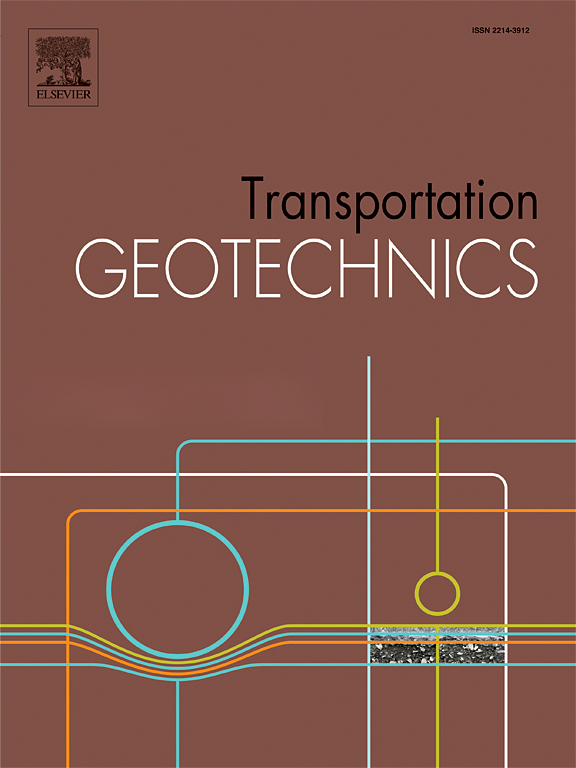Investigation on load sharing ratio of piles and soil in GRPS embankment with different pile types and geogrid layers under long-term cyclic loading
IF 4.9
2区 工程技术
Q1 ENGINEERING, CIVIL
引用次数: 0
Abstract
Geosynthetic-reinforced pile-supported (GRPS) embankments are a primary method for mitigating subgrade settlement. However, the load transfer mechanism between piles and soil remains incompletely understood, with the load sharing ratio (LSR) between piles and soil serving as a critical indicator for this mechanism. This study conducted a model test at a similarity ratio of 1:10 to investigate the effects of load amplitude, load frequency, number of geogrid layers, and pile types on the LSRs of piles and soil in GRPS embankments. The test results show that the pile’s LSR increases with rising values of these parameters, while the corresponding LSR of the soil decreases. Among these parameters, the number of geogrid layers has the least effect on the LSRs of both piles and soil. Furthermore, the rigid long pile demonstrates a higher LSR than the flexible short pile, attributed to its greater stiffness. The influence of load frequency on the LSRs of the rigid long pile is also less significant compared to the flexible short pile. Variations of LSR increment can be predicted using a formula that incorporates the number of loading cycles. These findings provide deeper insights into the load transfer mechanism in the pile-soil system, contribute to the optimization of GRPS embankments design practice, and ultimately enhance performance and reliability of the GRPS embankments in geotechnical engineering applications.
长期循环荷载作用下不同桩型和土工格栅层数GRPS路堤桩土荷载分担比研究
土工合成增强桩支撑(GRPS)路堤是减轻路基沉降的主要方法。然而,桩土之间的荷载传递机制尚不完全清楚,桩土之间的荷载分担比(LSR)是反映这一机制的重要指标。本研究采用相似比为1:10的模型试验,研究荷载幅值、荷载频率、土工格栅层数、桩型对GRPS路堤桩土lsr的影响。试验结果表明,随着这些参数的增大,桩的LSR增大,而相应的土的LSR减小。在这些参数中,土工格栅层数对桩和土的lsr影响最小。刚性长桩比柔性短桩具有更大的刚度,具有更高的LSR。与柔性短桩相比,荷载频率对刚性长桩lsr的影响也较小。LSR增量的变化可以使用包含加载周期数的公式来预测。这些发现有助于深入了解桩土系统荷载传递机制,有助于优化GRPS路堤设计实践,最终提高GRPS路堤在岩土工程应用中的性能和可靠性。
本文章由计算机程序翻译,如有差异,请以英文原文为准。
求助全文
约1分钟内获得全文
求助全文
来源期刊

Transportation Geotechnics
Social Sciences-Transportation
CiteScore
8.10
自引率
11.30%
发文量
194
审稿时长
51 days
期刊介绍:
Transportation Geotechnics is a journal dedicated to publishing high-quality, theoretical, and applied papers that cover all facets of geotechnics for transportation infrastructure such as roads, highways, railways, underground railways, airfields, and waterways. The journal places a special emphasis on case studies that present original work relevant to the sustainable construction of transportation infrastructure. The scope of topics it addresses includes the geotechnical properties of geomaterials for sustainable and rational design and construction, the behavior of compacted and stabilized geomaterials, the use of geosynthetics and reinforcement in constructed layers and interlayers, ground improvement and slope stability for transportation infrastructures, compaction technology and management, maintenance technology, the impact of climate, embankments for highways and high-speed trains, transition zones, dredging, underwater geotechnics for infrastructure purposes, and the modeling of multi-layered structures and supporting ground under dynamic and repeated loads.
 求助内容:
求助内容: 应助结果提醒方式:
应助结果提醒方式:


